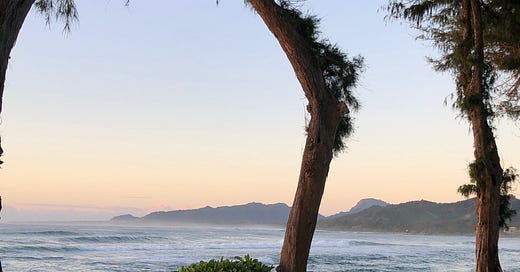She's called again...
15 minutes to sunrise. The ground is damp, the crab grass sticky between my toes. The hala tree near the beach has dropped its hard-shell orange cones sprinkled all around its base.
We get to the beach to watch the show. A few others lingering, some with cameras ready. A couple of crabs scamper over the exposed rocky part of the beach.
It’s a ritual not to be missed. The sun makes its first promise of an appearance lighting the clouds on the horizon in a soft pink glow, beams of white light arcing around them until the crescent yellow giver of life begins to rise steadily over the Pacific Ocean.
Each moment a worthy image. The sky over Sleeping Giant Mountain rainbow rays of orange, blue and yellow. A pair of red-crested cardinals pick at the grass. A chicken saunters by, six tiny chicks in tow.
When she calls, there is no saying no to this island.
I know from years of following this call, walking on her, painting her landscapes, she is no ordinary island.
I can’t explain the relationship in terms that would make sense in a normal conversation so I don’t bother to try. But I note and observe the hold she has on those who travel to her, who feel repeatedly, as I have, that I must return, year after year, year after year, again and again, come back, come back, come back...
She’s teaching something. She’s emblematic of something we crave. I crave. Nature. Perhaps it’s because she’s an isolated small island in the middle of the Pacific Ocean.
I speculate that Kauai’s magic perhaps has a lot to do with her isolation. Referred to as the Separate Kingdom because she was never conquered by the Kings of the other Hawaiian islands, she has a characteristic of standing apart. The channel between her and Oahu is known to be treacherous and the way the ocean currents run, she was likely settled separately to the other Hawaiian islands when the first Polynesians arrived many hundreds of years ago.
Chuck Blay, a geologist whom I had the pleasure of meeting in Kauai has written the definitive geologic history book on Kauai. He notes:
“From a myopic human perspective, the islands of Hawaii represent one of the last habitable parcels of land on our planet discovered and occupied by our species. There is little or no direct evidence of human contact of any kind before about 900 CE. The first significant “settlements’ made from the south by ocean voyaging Polynesians were not established until around 1000-1200 CE.” (p.1)
This makes sense to me on many levels.
She’s called again. I heed her call.
She floods my inner vision with scenes daily so it is like I live in two places at once. In my ecopsychology class a question rolled in from a student who asked if he could do his special place assignment in two places since he’s moving mid-semester.
Yes, two places are fine, I replied.
I ‘m also doing the assignment in two places also. She is teacher and muse.
I am reminded of the title of Lucinda Fleeson’s memoir of living on Kauai titled Waking Up in Eden: In Pursuit of an Impassioned Life on an Imperiled Island.
It’s time to get ready to return to the Eden that is Beloved Kauai. Time to wake up, roll out of bed, watch the sunrise from the beach. Watch the waves roll in.
The Kauai Writers Conference starts in 10 days. This time to coincide with a spectacular Full Moon Lunar Eclipse on November 8.
Aloha.
Reference:
Blay, C., Siemers, R. (2013). Kauai’s geologic history: A simplified overview. The Edge of Kauai Investigations





